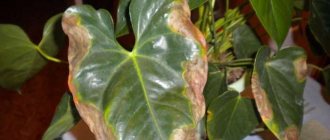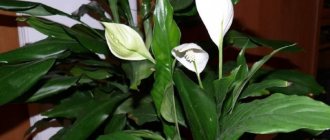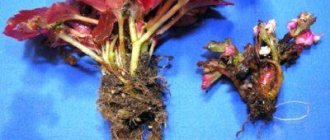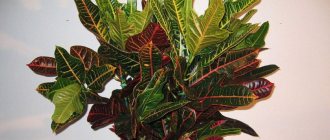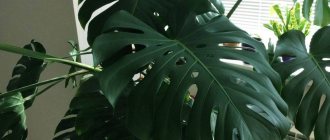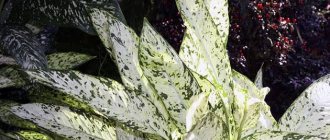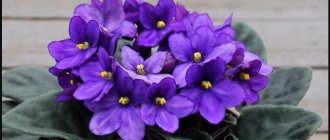Features of care
Anthurium is considered a capricious plant, for the correct growth of which many conditions must be observed. Sometimes even experienced gardeners make mistakes when growing it. The main thing you need to know is that anthurium deteriorates due to direct sunlight, so it needs to be kept in a slightly shaded place or illuminated with fairly bright but diffused artificial light.
The optimal air temperature for plant growth in summer is +20...+24°C, and in winter - +14...+16°C. But in winter there are short daylight hours, so during this time you will have to provide the anthurium with an additional source of lighting. If you ignore this requirement, the plant will inevitably fade. If the question arises as to why anthurium leaves dry and what to do to solve this problem, then you first need to determine whether the following conditions and recommendations are met:
- A plant that stands in a room with dry air must be constantly sprayed with a fine spray bottle. But splashes of water should not be allowed to fall on the inflorescence, as this will cause it to become covered with white spots.
- It is advisable to water the anthurium with slightly warm water. In summer this should be done three times a day, and in winter - once a week.
- The growing season begins in March and ends in October, so during this period you need to fertilize the plant with various nutrients (for example, foliar fertilizers), which must be applied in small portions.
- Faded inflorescences must be cut off, as they form seeds.
- After transplantation, anthurium is extremely sensitive to lack of moisture, so at first it needs to be constantly sprayed and watered.
These are the basic rules, which are the responsibility of the grower. However, if the leaves of the anthurium begin to dry out, what to do to correct this situation must be decided quickly, since in this case there is a high risk of the plant dying.
Unsuitable conditions and care
The most common causes of yellowing leaves are associated with improper care and conditions of keeping the flower.
Air temperature and humidity
Anthurium leaves turn yellow from the edge to the middle .
A special feature is massive damage to leaf blades. Most often, this problem occurs in winter, when the heating system is turned on. After the edges of the leaves dry out, they begin to turn black. The affected leaves fall off, and new ones grow deformed, as the flower lacks moisture.
To solve the problem, you can buy an air humidifier . The device is capable of maintaining indoor humidity within 70-80% - this is the optimal humidity level for many tropical plants. If it is not possible to purchase a humidifier, then the flower will require careful care. The plant will need to be sprayed 2-3 times during the day, and the leaves will need to be wiped with a damp cloth.
Important! It is impossible to restore affected leaves.
Not only humidity plays a big role, but also the air temperature in the room . It should be from 16°C to 28°C. Anthurium does not tolerate drafts, so it cannot be placed in rooms where they are present.
Lighting
In the summer, when direct sunlight hits the flower, burns in the form of yellow spots appear on the leaves. Since in nature the plant lives in the tropics, mainly in shady areas, it is not prepared for the aggressive effects of the sun.
If it is not possible to move the anthurium to a darker place, then it is necessary to cover the windows with sun protection film.
The complete absence of light will also have a harmful effect on the flower . It will stop growing, bloom rarely, and the leaves will begin to turn yellow. To solve the problem, you should move the plant to a more illuminated place or use an additional light source.
Soil composition
Soil that becomes dense over time is not suitable for anthurium, as it loses breathability and dries out quickly.
Therefore, a loose substrate with sufficient air and water permeability and acidity is selected for the flower. Also, 2-3 times a year it is necessary to replant the plant , its roots grow, fill the free space in the pot, and as a result the soil is depleted.
Watering
Anthurium loves moisture; it needs to be watered often, but not abundantly. Excessive watering or lack of watering can cause yellowing of anthurium leaves. If you fill a flower with water, the root system will begin to rot, and fungal diseases may develop.
You can adjust the watering mode based on the condition of the leaf plates. Brown or yellow spots appear when overwatering . Only drying the substrate will help solve the problem. If there is no drainage layer, then the soil should be replaced.
If you forget about watering, then yellowness will appear along the edges of the leaves and they will begin to wither. Water quality can also negatively affect the condition of the flower. With a high content of salts and chlorine in the water, the leaves begin to wither.
For reference! It is better to water the anthurium with boiled or settled water at room temperature.
Causes of drying out
Making a diagnosis and starting treatment for a plant is a difficult task, since most often the disease occurs due to improper care. If anthurium leaves dry out, what should you do to fix it? Few gardeners know the answer to this question. As a rule, such a nuisance occurs when the flower is in a room whose humidity does not correspond to the required level for proper plant growth, equal to 65–80%.
In this case, the anthurium will be attacked by spider mites, which will cause the leaves to lose their fresh appearance, turn yellow and curl. In turn, in rooms without normal ventilation, there is a high probability that the plant will be exposed to an infectious disease.
But there are many other reasons why leaves begin to dry:
- weak or poorly organized watering;
- flower damage by mealybugs or thrips;
- various diseases (for example, anthractic blight or stem rot);
- draft;
- non-compliance with the feeding schedule and excess nutrition;
- dry air;
- lack or excess of lighting, etc.
The result of a long violation of the maintenance rules is a dead plant. Experienced flower growers should definitely know why anthurium leaves dry out. According to them, this can also happen due to an attack by insects, the result of whose harmful activity is a damaged root system of the plant, and consequently, the destruction of the above-ground part. However, it is necessary to take a closer look at the main reasons so that beginners growing anthurium can cure it in a timely manner.
Why do anthurium leaves turn yellow?
In a healthy plant, the surface of the leaves looks smooth, shiny or matte. In some species it is velvety. Moreover, it is made decorative not only by inflorescences of greenish, white or bright colors (pink, red, purple), but also by leaf plates - solid, deeply dissected. The types with cut edges are especially good.
At home, most often, you can find such popular decorative foliage varieties of anthurium as:
- crystal;
- Andre (white, red);
- Schurzer, Hooker, Veitch.
If you notice a spot (yellow, brown or black) on the surface of dark green leaves, then there is a reason that spoils their appearance. Perhaps this is a sign of plant disease.
Why does anthurium turn yellow at home?
First of all, the leaves of the anthurium begin to turn yellow. And it is quite natural that a gardener, especially an inexperienced one, wonders why and for what reason such undesirable changes occur.
The most common reason is non-compliance with plant care rules. However, quite often anthurium can turn yellow after being purchased in a store, once at home. Because the air in the apartment is drier and the temperature is completely different, the flower will need some time to adapt to the lighting.
If the anthurium leaves continue to turn yellow, solving the problem will take longer and will require knowledge of specific measures to help.
Reasons why anthurium leaves turn yellow:
- excessive watering, stagnation of water in the pan, spoils the root system of the flower, which leads to the appearance of yellowness on its leaves. The same effect will be achieved by using hard water (including when spraying);
- direct sunlight hitting the surface of the leaves causes a burn, from which the foliage begins to turn yellow and then dries out. A similar result is noted in insufficient lighting of the place where the pot with anthurium is located;
- the conditions of growing a flower in a too tight or very loose pot, as well as a lack of substrate, are fraught with yellowing of the leaves;
- negative impact of low temperatures. In winter, when anthurium is left near an open window, or in spring, if a plant placed on a balcony is forgotten to be brought into the apartment when it gets colder, it results in yellowing of the leaves.
In addition to these reasons, the leaf turns yellow due to attached pests - aphids, mealybugs. They suck the juices out of the plant and it turns yellow.
And also, perhaps, the flower is affected by fusarium. In this case, total yellowing of the leaves and their wilting are observed.
A deficiency of iron and magnesium in the soil is the cause of an infectious disease called chlorosis. In this case, yellowness on the leaf plate is inevitable.
If there is not enough nitrogen in the substrate, this will cause yellowing of the lower leaves of the anthurium. The appearance of the plant will suffer in the same way from a lack or excess of sulfur and manganese in the soil.
Why do anthurium leaves turn yellow after transplantation?
It happens that after transplantation, the leaves of a flower begin to turn yellow. Obviously, this was facilitated by the actions of the grower, due to which the plant became worse:
- During transplantation, the root system of the anthurium was damaged;
- the soil has been chosen incorrectly or the crop is adapting to new conditions;
- After transplantation, the flower was over-watered.
First of all, this concerns the complete replacement of the soil. For example, if you leave part of the “store-bought soil” in the pot and then add your own, then after replanting it will be difficult for the plant to adapt to two substrates that are completely different in air and water permeability, nutritional properties, and substrates.
Tip: to transplant a healthy flower, use the transshipment method.
The capacity of the flower pot must correspond to the volume of the root system. When replanting later, it is increased by one size (a space the size of a finger remains between the old lump of soil and the edge of the pot).
Natural cause: aging
Anthurium leaves may turn yellow due to old age. This is an inevitable process, so don't worry too much about it. With aging, the leaves that are located closer to the ground gradually die off. Yellowness covers the edges of the leaf plate, and then covers the entire leaf, as a result of which it loses its elasticity and turns brown. If the anthurium is kept in proper conditions, the shedding of old leaves is a natural process that does not harm the plant, since new foliage will appear at its top over time.
However, the flower can be helped in some way. To do this, you need to cut off the yellowed old leaves, making the anthurium more attractive and making its life easier. To avoid infecting the plant with an infection, the knife must be treated with alcohol, and the cut area must be sprinkled with a little charcoal. However, do not forget: the leaf cannot be torn off by hand, as this will lead to injury to the stem.
Anthurium care at home. Anthurium
Anthurium.
House Anthurium, flamingo flower or male happiness - family...
Homeland of the plant. South America, plants come from South American tropical forests, where temperatures range from 20 to 25 degrees. Plants develop under the forest canopy and are not exposed to direct sunlight.
Height of indoor anthurium. Up to 50 cm; more compact forms of house plants have modest sizes and reach 30 cm; anthuriums develop slowly. Tall stems may need to be trimmed.
1. Anthurium - home care
1.1. Anthurium transplantation
The best time to repot is spring; replant the plants in a larger pot with larger drainage holes only as needed. It is better to use gentle handling of plants. The bushes are replanted when the pot becomes cramped - this is indicated by the tips of the roots emerging from the drainage holes or the roots appearing on the surface of the soil around the plant. For planting, you can use a pot that will be 3-4 cm in diameter larger than the previous one. When planted in a pot that is too large, the plant stops the growth of the above-ground part until the root system has mastered the entire volume of the container. When replanting, you should be careful - the roots of the flower are fragile and easily break off when touched. The root system must be inspected and old and rotten roots are cut off with a sharp, sterile instrument, treating the cut areas with crushed charcoal. Try not to replant flowering specimens. After transplantation, watering is stopped for 3-5 days, giving the root system time to adapt to the new soil. Also, stopping watering is necessary in order to heal possible wounds on the roots that could appear during transplantation.
Irrigation violation
Anthurium does not tolerate both waterlogging and lack of moisture. The roots of the plant are sensitive to excess water. Moist soil is an ideal environment for bacteria and fungi. In addition, anthurium can only be watered with melted or settled water (settling time is at least two days)
If the plant stays in waterlogged soil for a long time, the tips of the anthurium leaves will begin to dry out. What to do in this unpleasant situation, when tissue necrosis begins to develop from the edges and gradually spreads to the entire leaf? To solve this problem, you need to dry the soil in the pot. If this does not help, it means that the root system of the plant has rotted, so the leaves lack nutrients. There is only one solution - remove the damaged parts and replant the anthurium in fresh soil.
However, the leaves may begin to dry out in the middle. The reason for this may be accidental ingress of water onto the leaf plates. For sunlight, such drops are a kind of lens, so they will simply burn through the living tissue of the plant. In addition, in anthurium that is in a cool room, improper watering can cause fungal disease.
Table - to help diagnose the disease
| Causes | Symptoms |
| Dry air |
|
| Bright light/direct sunlight |
|
| Lack of light |
|
| Watering with hard water, excess calcium |
|
| Watering with cold water |
|
| Waterlogging of the soil, overwatering |
|
| Lack of nutrition |
|
| Excess nutrition |
|
| Watering with chlorinated water |
|
| Hypothermia |
|
| Improper care |
|
Pests and diseases | |
| Anthracnose and septoria | Round or oval red-brown, yellow spots from 1.5 to 13 millimeters, often a black dot (spores) can be seen inside. The stain spreads across the leaf and forms holes. |
| Fusarium wilt | Massive, rapid withering of leaves and unnatural bending of peduncles and petioles, dark vessels are visible on the cut of leaves, roots rot. |
| Root rot | The leaves lose their shine, become lighter, and then turn black. Upon examination, the roots are rotten and frayed, the root sheath is separated from the core. |
| Powdery mildew | The leaves curl, turn yellow, become smaller, and a white coating appears on the underside of the leaf. |
| Rust | Red-brown spots on the bottom of the leaf and at the same time light spots on the top, death of the affected leaves. |
| Aphid | The leaves curl, turn yellow, and become covered with a sticky coating. Small green sucking insects are visible inside the leaves and on young shoots. |
| Trips | Affected leaves have an uneven yellow-green color, and the inside of the leaf is covered with black insect excrement. The leaves dry out and fall off. |
| Shchitovka | Whitish or golden tubercles on the leaves. |
| Spider mite | The leaf becomes covered with yellow specks, curls, and dries out. When finely sprayed, a web with insects is visible. |
| Mealybug | The affected parts of the plant seem to be dusted with flour |
You might be interested:
- Dieffenbachia leaves turn yellow
Dieffenbachia is a plant about which you can hear many different opinions. Some say that it is very... - Cucumber leaves turn yellow One of the problems when growing cucumbers is yellowing of the leaves. If measures are not taken in a timely manner, then...
- Why do monstera leaves turn yellow and fall off? Monstera is an unusual plant. Probably every owner of this marvelous vine has noticed that in cloudy weather...
Incorrect lighting
It is best to place the anthurium in partial shade. If the plant grows weakly or has stopped blooming altogether, it means that it does not have enough sunlight or artificial light. During the period of short daylight hours, when the anthurium ceases to receive the proper amount of energy, the leaf plates become smaller and dry out a little. In this case, the flower must be placed in a place where more sunlight falls in winter. As a result, the stains will disappear over time.
However, you cannot stay in the direct rays of anthurium for a long time, as this will cause the leaves to turn yellow. According to the recommendations of flower growers, to solve this problem, you need to cover the glass with a tinting film, the purpose of which is to reflect most of the solar radiation. In addition, the plant can be placed away from the glass.
If the tips of the leaves of an anthurium dry out, what should you do to save the plant in winter? Flower growers, when they hear this question, say: it is necessary to provide the flower with an additional source of lighting. For these purposes, special phytolamps or other lamps are used for additional illumination.
Excessive dry air is the cause of dry anthurium leaves
Similar symptoms can be seen in anthurium placed in a room with dry air. Most often, this reason makes itself felt at the beginning of the heating season, when the plant’s usual conditions change, and aerial roots and foliage can no longer obtain the required amount of moisture from the air.
Why do anthurium leaves turn yellow in this case? They simply don't have enough food. Yellowness spreads from the edges of the leaf blades to the center, then the tissue on the tips and edges of the anthurium leaves dries. Young leaves developing in dry air often cannot unfold properly and are deformed or damaged.
You cannot do without additional air humidification, and you can achieve the humidity required by anthurium of about 70–85% using a household humidifier, as well as improvised means. The plant responds well if the tray is filled with fine expanded clay and filled with water. The pot is placed on the filler so that the roots do not have contact with moisture.
Do not forget that changes in temperature and light conditions necessarily lead to the soil drying out faster or slower, and the plant’s mode of moisture consumption also changes.
This means you will have to change the watering schedule. It is improper soil moisture under a houseplant that most often provokes the formation of brown spots, dry areas and yellowness on the leaves of the anthurium.
Lack or excess of nutrition
If the anthurium suddenly stops growing and its leaves dry out or turn yellow, this may be due to a nutrient deficiency. Lack or absence of phosphorus, potassium, nitrogen, magnesium and other elements will cause the plant to turn brown.
Special ready-made liquid products are used as fertilizers. Thanks to their effect, the diseased anthurium will restore its healthy and blooming appearance. These medications should be used weekly. As soon as the plant acquires its former strength, mineral fertilizing is applied once every 14 days.
However, not only a deficiency, but also an excess of fertilizers can be the reason why anthurium leaves dry out. In this case, the root system must be washed in warm water and treated with a disinfectant, and then the plant must be transplanted into a pot with new soil.
How to care for a flower?
Anthurium does not require round-the-clock monitoring and care. The main thing in caring for a plant is watering, replanting and fertilizing .
In order for a flower to stay in the house for a long time, you need to be careful about watering it. To determine how dry the soil is, you can use the weight of the pot as a guide. If it's light, then it's time to water. If, on the contrary, it is heavy, you can postpone watering.
In summer, it is enough to water the anthurium once every 1-1.5, but it is still advisable to wipe the leaves with a damp sponge. In winter - once every 2 weeks. Water the flower with settled water at room temperature.
Important! Any water that leaks into the pan must be drained immediately, otherwise it will stagnate and cause rotting of the roots.
Anthurium is replanted annually if the flower is young. If an adult, then once every 2-3 years. The most favorable time for transplantation is spring .
As for feeding, in summer fertilizers with potassium and phosphorus are added to the soil. In winter, if the plant does not bloom, then feeding should be stopped. Fertilize the flower every 2-3 weeks.
Home anthurium is easy to care for. You just need to follow the rules of watering and caring for the plant. Inspect the leaves regularly and try to correct any problems immediately. Then the plant will bloom for a long time and delight you.
Dry air
This is a fairly common problem in homes with central heating. If the tips of the leaves of an anthurium dry out, the plant may lack moisture, because it evaporates too quickly in a heated room. More often this happens when the flower stands on a wide windowsill, under which a heating radiator is installed. There are several ways to increase humidity and improve the microclimate of the room for better growth of anthurium:
- Place the pot with the plant on a tray with damp expanded clay or sphangum (another name is peat moss).
- Constantly spray the leaves with warm water so that the drops do not fall on the inflorescences.
- Place a special humidifier next to the anthurium.
- Place a container of water near the battery or place a wet towel over it.
In any case, placing an anthurium near a heating device is a bad idea. In addition, you should not water the plant frequently to increase the humidity in the room.
How to propagate a plant?
When an anthurium is in an environment suitable for its growth, it, like all other flowers and plants, begins to reproduce. This happens by the appearance of small shoots – “babies” – near large plants. Their separation is the most common option for flower propagation. It is advisable to do this directly during transplantation. Very carefully, the shoot is separated from the adult plant using a knife, and the cut area is rubbed with charcoal. Next, the anthurium is planted in a separate pot according to technology
There is another method that involves propagation from the stem. To do this, the stem and leaf are placed in a container of water and covered with a glass jar to create an air dome. After some time, the stem will take root, then it will need to be planted in a pot.
What to do if the anthurium has brown spots on the leaves, see the following video.
Draft and cold
If the leaves of an anthurium dry out, what should you do (the photo shows a clear example of this problem) to save the plant? Flower growers answer: you cannot place a flower pot near the balcony door, which residents often open in winter. If you ignore this advice, there is a high probability that the anthurium leaves will dry out. To protect the plant from drafts and cold air, it must be taken out of the room for ventilation.
If the leaves of the anthurium are slightly frozen, the plant can be restored. All damaged organs of the flower must be carefully cut off and placed in a warm room. The next step is to treat the plant with a biogrowth stimulator. However, the root may be damaged, so in this case you will have to replant the anthurium after cutting off the rotten areas. It is advisable to treat the cut areas with cinnamon.
Fungal disease on anthurium
If the room is cool and watering is poor, there is a high risk of fungal disease. When fungi begin to work, dry spots appear on the leaves. First, small yellow spots of irregular or round shape appear, then they begin to expand, and the center becomes brown and begins to dry.
The damaged areas may begin to crumble and dark circles may form around the area. But when fungi attack, not only the foliage suffers - the roots begin to rot. Therefore, you must definitely pull out the plant and check its roots, cutting off all rotten areas. Healthy roots should be light cream or white in color. If they turn brown or black, soft spots appear, possibly with areas of mucus - this is rot.
After cutting off the rotten roots, the cut sites are treated with crushed coal, and the anthurium itself is treated with a fungicide. In this case, before processing, you need to remove all leaves damaged by the fungus.
The pot needs to be disinfected and filled with fresh substrate.
Anthurium leaves dry out in patches due to pests: what to do
The plant may turn yellow not only due to improper maintenance conditions. An equally common cause is leaf damage by various pests:
- When the anthurium becomes covered with yellow spots and begins to dry out sharply, you must immediately inspect the underside of the leaf plate. If small insects of green, black or gray colors are visible there, it means that the plant has been attacked by aphids. They feed on the sap of leaves. To save the plant and destroy aphids, you need to treat the anthurium with an infusion of garlic, onion or tobacco. But it is better to use chemicals - insecticides.
- The presence of thrips - insects similar to small flies - on the plant is indicated by dried leaves of a yellowish-white color. Various drugs (for example, Intavir or Fitoverm) and sticky traps are used against them.
- If the leaves are covered with spots and the shoots are covered with cracks, it means that the plant has been affected by mealybugs. To eliminate them, karbofos is used.
- Due to spider mites attacking the anthurium, the leaves dry out in the middle. What to do to destroy these pests? It is necessary to use insecticides against ticks, otherwise the leaves will quickly dry out and turn yellow.
The main thing is to clean the anthurium with water a day after the chemical treatment to protect the plant from toxic substances. But first you need to protect the soil from excess moisture with plastic film.
Non-communicable diseases
The appearance of diseases is promoted by improper care of plants. Non-infectious diseases include smallpox, chlorosis, enation.
Plant pox
When a disease is caused by errors in care, various raised spots appear on the leaves. They can be yellow or yellowish-green in color. Such deformity of leaf plates can occur when the air humidity does not match the temperature.
On a note! We must not forget about timely feeding of anthuriums. After all, healthy specimens are less susceptible to diseases.
Chlorosis
The disease occurs as a result of a deficiency of two important elements - iron and magnesium. Their deficiency manifests itself in yellowing of the foliage or the appearance of yellow stains on the leaf blades.
Popular articles Collecting aster seeds correctly
Enatsii
The disease can be recognized by its ugly leaves. The first sign is that the foliage began to grow unevenly, the plates themselves become convex and humpbacked. Incorrect temperature contributes to the appearance of enation. The room may be too stuffy, too cold, dry or humid. Getting rid of the problem will help by establishing proper care for the plant and following agrotechnical growing practices.
- thrips;
- spider mite;
- scale insect.
Aphids are a malicious pest; it is advisable to fight them before the insects multiply. When a plant is massively infested with aphids, it becomes increasingly difficult to cure the flower. To combat, you can use chemicals or use a mechanical method of control: hang sticky tapes to catch flies near the plant itself.
The flower is suffering from a thrips invasion. To understand that this particular pest has infested the plant, you need to carefully examine the underside of the leaves. Black dots indicate its presence. The insect is active in spring and summer.
Not only adult thrips are dangerous, but also their larvae. Feeding on the sap of the plant, they gradually lead to its death. You can fight thrips using pesticides
It is better to buy in specialized stores, paying attention to the expiration date of the drug
Insects appear on plants that are not properly cared for. To minimize errors, you need to carefully monitor the anthurium, water it in a timely manner, feed it and, of course, provide the plant with a flow of fresh air by ventilating the room daily.
If an anthurium is damaged by a scale insect, you need to prepare for the fact that the fight against it will be lengthy. And it depends only on the persistence of the owner whether the result will be positive or negative. At the early stage of pest appearance, it is unlikely that you will be able to see them with the naked eye. Bugs have a durable shell, so when treated with chemicals, good results are not always obtained.
Before spraying the plant with insecticides, you need to soap the sponge with laundry soap and wipe the plant itself, leaving the soap foam on the flower for half an hour. Then you need to wash the flower in the shower, let it dry and only then carry out the treatment.
You need to spray the plant 3 times with an interval of 7 days. If this condition is not met, scale insects will appear again, since some of the adult individuals are in the soil.
Attention! When treating anthurium against scale insects, you need to spill the soil with a weak solution of the prepared preparation, or even better, replace the old soil with new one. Spider mites are no less dangerous pests
Thanks to its vital activity, the leaves of the plant begin to turn yellow, gradually curl and fall off. You can tell that there is a spider mite infestation by looking at the thin web that will be located on the back of the leaf.
Spider mites are no less dangerous pests. Thanks to its vital activity, the leaves of the plant begin to turn yellow, gradually curl and fall off. You can tell that there is a spider mite infestation by looking at the thin web that will be located on the back of the leaf.
The pest can be controlled with folk remedies. First you need to wash the plant in the shower and free it from cobwebs. Then you need to wipe the surface of the leaves, the pot itself, and the window sill on which the anthurium stood with a sponge and laundry soap.
Infectious diseases
If the leaves of an anthurium dry out, the flower needs to be isolated from healthy plants, examined and a final diagnosis made. The following diseases exist:
- Root rot occurs due to low soil acidity and constant waterlogging. With this disease, the leaves of the anthurium will begin to fade. To save the plant, it must be promptly transplanted into new soil, cutting off the rotten parts of the root system and washing it with a solution of potassium permanganate. It is advisable to add perlite to fresh soil to distribute moisture in the soil.
- Stem rot is a fungal disease that causes black spots to appear on leaves and stems. More often this disease occurs due to increased soil moisture. To save the anthurium, you need to cut off the rotten parts, and then treat the flower with fungicides (for example, Fitosporin).
- Anthracticosis is an infection that often occurs at elevated temperatures (more than 25°C) and humidity. The leaves will suffer more severely: dry spots will appear on them, which may crack. If the plant is not cured, its ground part will become completely covered with ulcers, which will cause the death of the flower. In case of anthractic disease, you need to reduce watering and spray the anthurium with fungicidal preparations.
How to save an anthurium if there is a stump with leaves left
The luxurious anthurium was crushed, rotted, and a stump with leaves remained? You will have to use a radical method of preserving the culture: completely cut off the stems, leaves and flowers, remove the anthurium from the soil, carefully examine the rhizome for rotting, clean or cut it, treat it with an anti-parasite agent. Replant into a healthy soil mixture.
Anthurium requires urgent transplantation
Anthurium is a beautiful and unpretentious exotic crop. When keeping a plant at home, it is worth establishing proper care and disease prevention. The flower will decorate the interior for more than 10 years.

